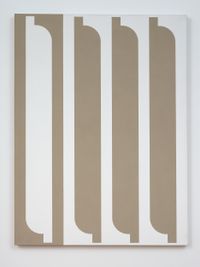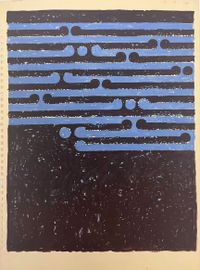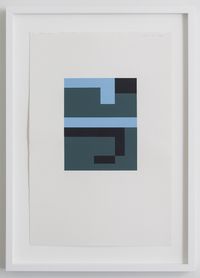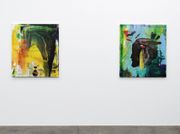Gordon Walters was a New Zealand-based modernist painter, printmaker and graphic designer known for his controversial synthesis of Māori and European design motifs.
Read MoreWalters was born in 1919 in Wellington, New Zealand. As a child, he was fascinated by the Māori and Pacific collections in Wellington's Dominion Museum. In 1935, Walters enrolled at Wellington Technical College to become a commercial artist. During World War II, he worked as an illustrator for the Ministry of Supply.
In 1946, Walters travelled to Australia where he met the artist Theo Schoon, who was photographing Māori rock art in South Canterbury. In 1950, Walters travelled to London and Paris where was influenced by the works of artists such as Piet Mondrian, Paul Klee, Auguste Herbin and Victor Vasarely.
In 1953, Walters returned to Wellington and synthesised what he had seen into painting modernist versions of the koru—a spiral-shaped motif which symbolises life, growth and peace in Māori art and culture. Walters gradually adapted the motif, straightening it and later incorporating circles and triangles, as seen in Painting No. 9 (1965). He also painted highly abstracted versions of rock art figures, straightening them out and using rectangular centres and restrained colour.
Walters had his first solo exhibition in 1966 in Auckland, in which he showed a dozen black and white koru works.
Walters' work has attracted much debate, with some Māori academics—like Rangihiroa Panoho and Ngahuia Te Awekotuku—accusing the artist of cultural theft, colonialist appropriation and misuse through his avoidance of underpinning symbolism or narrative. Others—like Francis Pound and Michael Smythe—vehemently defended him.
Throughout his career, Walters was deeply interested in the ways shape, repetition, tonal value and colour are experienced, and the visual consequences of even subtle modifications to an image.
The pleasures of orchestrating such changes within an image obsessed him to explore ideas such as optically 'transparent' planes; grids of repeated curved motifs; en abyme compositions (an image residing inside a bigger version of itself, an identical or flipped outer image); the effect of tonally matched chromas; optically unrestrained coloured koru works; and coloured gouache versions of drawings made by the hospitalised patient Rolfe Hattaway.
Gordon Walters' artwork has been shown in solo exhibitions at Starkwhite, Auckland (2020 and 2015) and Dunedin Public Art Gallery, Scotland (2017). His work is held in instiutional collections such as Auckland Art Gallery Toi o Tāmaki; Chartwell Collection, Auckland; Te Papa Tongarewa Museum of New Zealand, Wellington; Dunedin Public Art Gallery; Christchurch Art Gallery Te Puna o Waiwhetū.
Walters died in 1995 in Christchurch, New Zealand.
John Hurrell | Ocula | 2021







